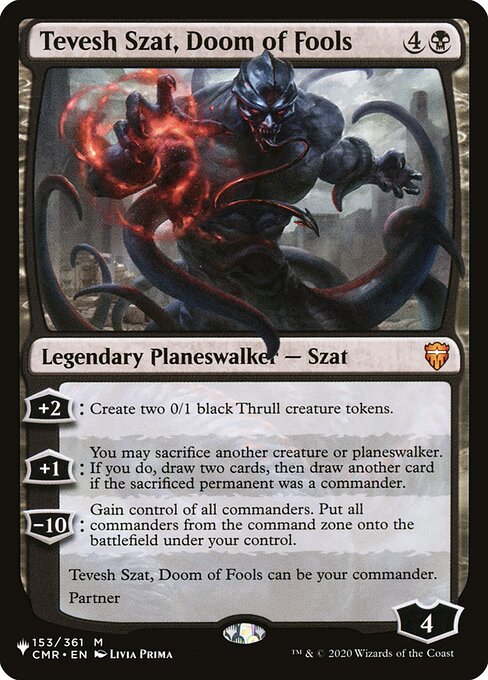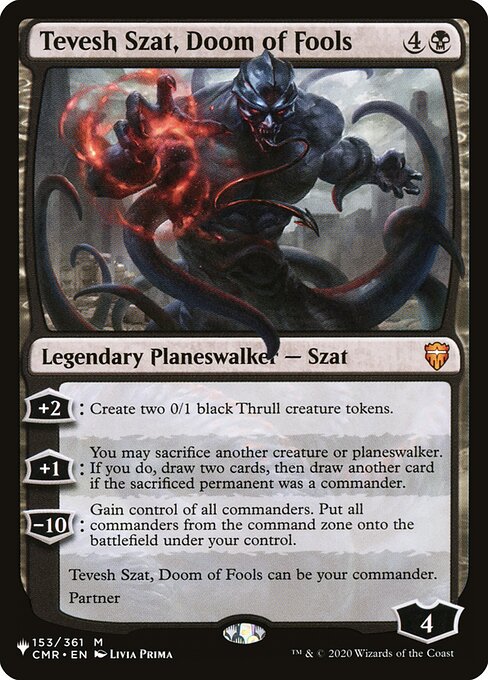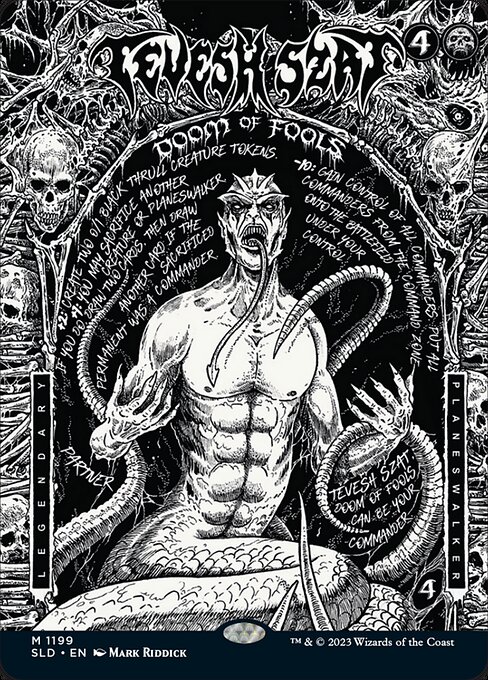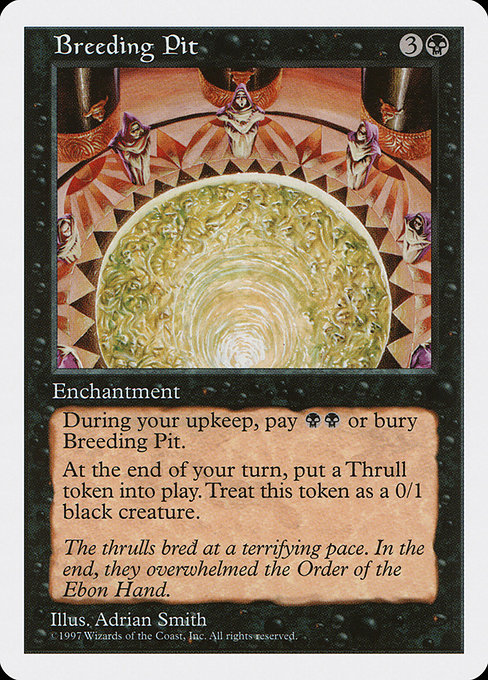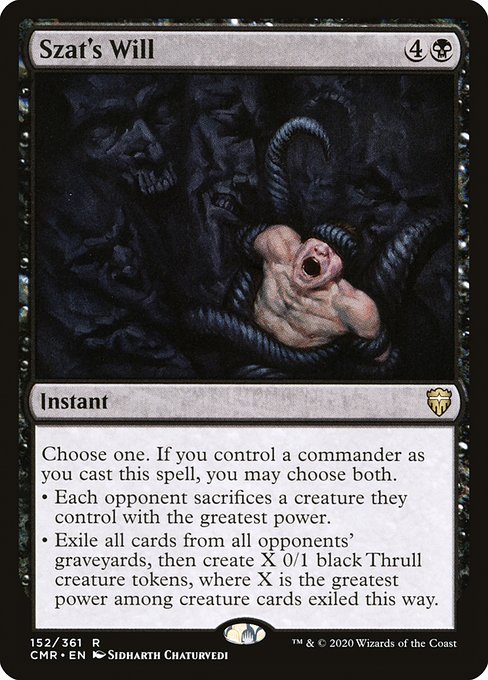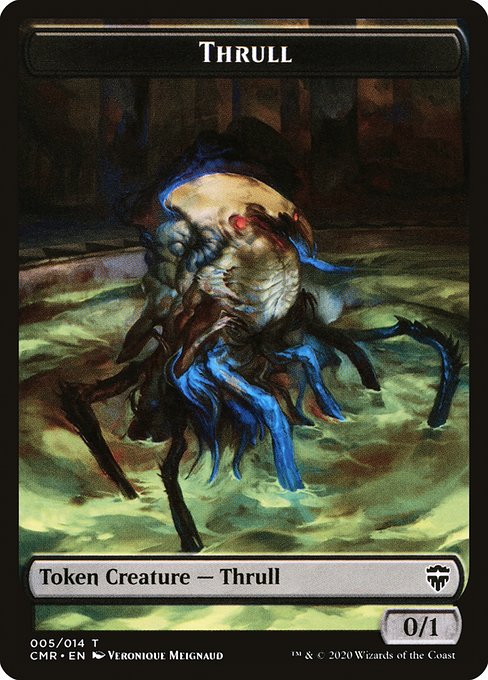Tevesh Szat, Trépas des imbéciles
Planeswalker légendaire : Szat
+2: Créez deux jetons de créature 0/1 noire Srâne.
+1: Vous pouvez sacrifier une autre créature ou un autre planeswalker. Si vous faites ainsi, piochez deux cartes, puis piochez une autre carte si le permanent sacrifié était un commandant.
-10: Acquérez le contrôle de tous les commandants. Mettez sur le champ de bataille, sous votre contrôle, tous les commandants de la zone de commandement.
Tevesh Szat, Trépas des imbéciles peut être votre commandant.
Partenariat
+1: Vous pouvez sacrifier une autre créature ou un autre planeswalker. Si vous faites ainsi, piochez deux cartes, puis piochez une autre carte si le permanent sacrifié était un commandant.
-10: Acquérez le contrôle de tous les commandants. Mettez sur le champ de bataille, sous votre contrôle, tous les commandants de la zone de commandement.
Tevesh Szat, Trépas des imbéciles peut être votre commandant.
Partenariat
standard
future
historic
gladiator
pioneer
explorer
modern
legacy
pauper
vintage
penny
commander
brawl
alchemy
paupercommander
duel
oldschool
premodern
Rulings
If you leave the game, each commander you gained control of is returned to its previous controller’s control. Each commander that entered the battlefield under your control is exiled (from there, its owner may return it to the command zone).
Once the game begins, your two commanders are tracked separately. If you cast one, you won’t have to pay an additional the first time you cast the other. A player loses the game after having been dealt 21 damage from any one of them, not from both of them combined.
Both commanders start in the command zone, and the remaining 98 cards (or 58 cards in a Commander Draft game) of your deck are shuffled to become your library.
You can choose two commanders with partner that are the same color or colors. In Commander Draft, you can even choose two of the same commander with partner if you drafted them. If you do this, make sure you keep the number of times you’ve cast each from the command zone clear for “commander tax” purposes.
As the third ability is resolving, you’ll gain control of all commanders that were already on the battlefield before the commanders from the command zone enter the battlefield under your control.
An effect that checks whether you control your commander is satisfied if you control one or both of your two commanders.
If something refers to your commander while you have two commanders, it refers to one of them of your choice. If you are instructed to perform an action on your commander (e.g. put it from the command zone into your hand due to Command Beacon), you choose one of your commanders at the time the effect happens.
To have two commanders, both must have the partner ability as the game begins. Losing the ability during the game doesn’t cause either to cease to be your commander.
For the second ability of Tevesh Szat, Doom of Fools, you choose whether to sacrifice anything and what to sacrifice as the ability resolves.
If your Commander deck has two commanders, you can only include cards whose own color identities are also found in your commanders’ combined color identities. If Falthis and Kediss are your commanders, your deck may contain cards with black and/or red in their color identity, but not cards with green, white, or blue.
Once the game begins, your two commanders are tracked separately. If you cast one, you won’t have to pay an additional the first time you cast the other. A player loses the game after having been dealt 21 damage from any one of them, not from both of them combined.
Both commanders start in the command zone, and the remaining 98 cards (or 58 cards in a Commander Draft game) of your deck are shuffled to become your library.
You can choose two commanders with partner that are the same color or colors. In Commander Draft, you can even choose two of the same commander with partner if you drafted them. If you do this, make sure you keep the number of times you’ve cast each from the command zone clear for “commander tax” purposes.
As the third ability is resolving, you’ll gain control of all commanders that were already on the battlefield before the commanders from the command zone enter the battlefield under your control.
An effect that checks whether you control your commander is satisfied if you control one or both of your two commanders.
If something refers to your commander while you have two commanders, it refers to one of them of your choice. If you are instructed to perform an action on your commander (e.g. put it from the command zone into your hand due to Command Beacon), you choose one of your commanders at the time the effect happens.
To have two commanders, both must have the partner ability as the game begins. Losing the ability during the game doesn’t cause either to cease to be your commander.
For the second ability of Tevesh Szat, Doom of Fools, you choose whether to sacrifice anything and what to sacrifice as the ability resolves.
If your Commander deck has two commanders, you can only include cards whose own color identities are also found in your commanders’ combined color identities. If Falthis and Kediss are your commanders, your deck may contain cards with black and/or red in their color identity, but not cards with green, white, or blue.
Rulings
If you leave the game, each commander you gained control of is returned to its previous controller’s control. Each commander that entered the battlefield under your control is exiled (from there, its owner may return it to the command zone).
Once the game begins, your two commanders are tracked separately. If you cast one, you won’t have to pay an additional the first time you cast the other. A player loses the game after having been dealt 21 damage from any one of them, not from both of them combined.
Both commanders start in the command zone, and the remaining 98 cards (or 58 cards in a Commander Draft game) of your deck are shuffled to become your library.
You can choose two commanders with partner that are the same color or colors. In Commander Draft, you can even choose two of the same commander with partner if you drafted them. If you do this, make sure you keep the number of times you’ve cast each from the command zone clear for “commander tax” purposes.
As the third ability is resolving, you’ll gain control of all commanders that were already on the battlefield before the commanders from the command zone enter the battlefield under your control.
An effect that checks whether you control your commander is satisfied if you control one or both of your two commanders.
If something refers to your commander while you have two commanders, it refers to one of them of your choice. If you are instructed to perform an action on your commander (e.g. put it from the command zone into your hand due to Command Beacon), you choose one of your commanders at the time the effect happens.
To have two commanders, both must have the partner ability as the game begins. Losing the ability during the game doesn’t cause either to cease to be your commander.
For the second ability of Tevesh Szat, Doom of Fools, you choose whether to sacrifice anything and what to sacrifice as the ability resolves.
If your Commander deck has two commanders, you can only include cards whose own color identities are also found in your commanders’ combined color identities. If Falthis and Kediss are your commanders, your deck may contain cards with black and/or red in their color identity, but not cards with green, white, or blue.
Once the game begins, your two commanders are tracked separately. If you cast one, you won’t have to pay an additional the first time you cast the other. A player loses the game after having been dealt 21 damage from any one of them, not from both of them combined.
Both commanders start in the command zone, and the remaining 98 cards (or 58 cards in a Commander Draft game) of your deck are shuffled to become your library.
You can choose two commanders with partner that are the same color or colors. In Commander Draft, you can even choose two of the same commander with partner if you drafted them. If you do this, make sure you keep the number of times you’ve cast each from the command zone clear for “commander tax” purposes.
As the third ability is resolving, you’ll gain control of all commanders that were already on the battlefield before the commanders from the command zone enter the battlefield under your control.
An effect that checks whether you control your commander is satisfied if you control one or both of your two commanders.
If something refers to your commander while you have two commanders, it refers to one of them of your choice. If you are instructed to perform an action on your commander (e.g. put it from the command zone into your hand due to Command Beacon), you choose one of your commanders at the time the effect happens.
To have two commanders, both must have the partner ability as the game begins. Losing the ability during the game doesn’t cause either to cease to be your commander.
For the second ability of Tevesh Szat, Doom of Fools, you choose whether to sacrifice anything and what to sacrifice as the ability resolves.
If your Commander deck has two commanders, you can only include cards whose own color identities are also found in your commanders’ combined color identities. If Falthis and Kediss are your commanders, your deck may contain cards with black and/or red in their color identity, but not cards with green, white, or blue.
Votre collection ? vos decks ?
Envie de gérer votre collection et/ou créer des decks ?
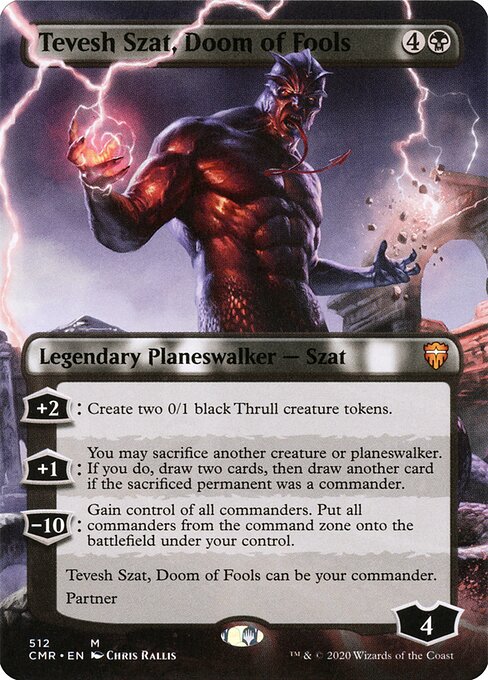

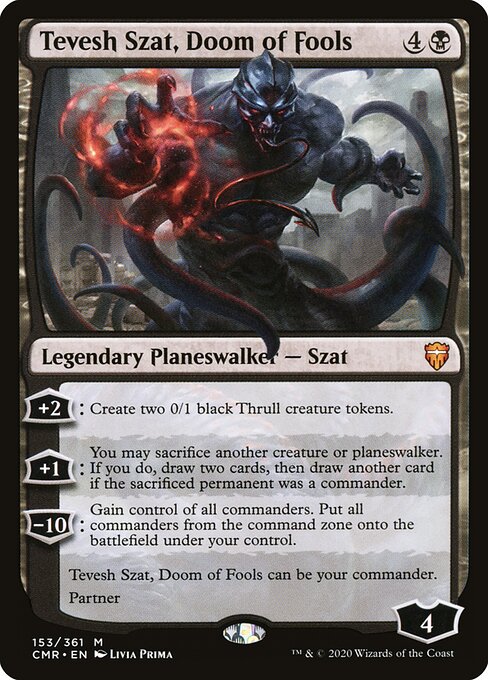
 0
0
 6.12€
6.12€
